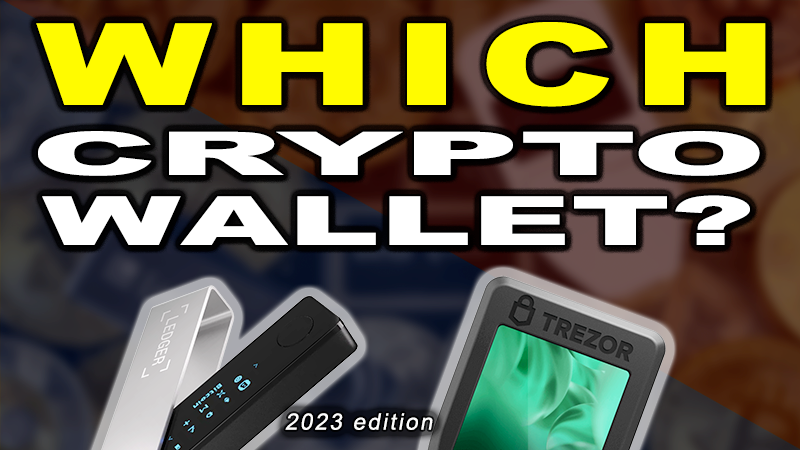
"Not your Keys? Not your Crypto."
If all of your crypto is on an exchange, do you really own it?
If that exchange gets shut down or if an employee decides to walk away with the company's coffer, how would you get your money back?
The short answer is you won't.
There is little to no protection for a crypto investor with their assets in a crypto exchange. The FDIC won't protect you from large losses if the exchange goes under or if they just decide they don't like you and they don't want to honor your deposit.

If you have more than $10,000 worth of crypto, a small $70 investment in a hardware wallet can prevent such a disaster and can offer you peace of mind.
There are 2 major hardware wallet manufacturers and many models to choose from, so which do you choose?
Not only will I show you your best harware wallet options, but you could be one of THREE WINNERS of a Trezor 1 crypto hardware wallet!
Why use a Hardware Wallet?
Even if you're new to crypto, you've probably heard the mantra “NOT YOUR KEYS, NOT YOUR COIN!”
The reason why this is such a common phrase is because crypto exchanges and other crypto sites are known for flying by the seat of their pants. They usually have bad security, bad management, and there could just be good ol' fashioned malice!
All these factors should make you want to get your crypto off these sites and in your control as soon as possible. And the best place to store your crypto is on a hardware wallet.
Which Hardware Manufacturer Should you Use?
The two major hardware wallet manufacturers are Ledger and Trezor.
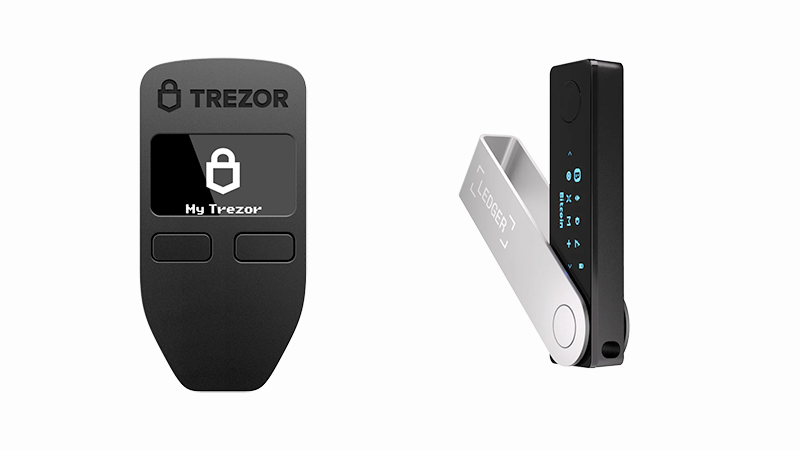
Both companies have been supplying HODLERS with secure crypto hardware wallets since the mid 2010s. Trezor was first to market and released the Trezor One in 2014, and Ledger released the Ledger Nano in 2016.
Both wallets can safely authorize the outbound transfer of many different cryptocurrencies without the user having to know or manually secure the private key associated with each address.
Both companies provide solutions for around 70 to 80 dollars that secure your private keys behind a seed phrase using the BIP 39 specification, and both companies have done a great job keeping customers' crypto secure.
I don't really think one wallet offers more security than the other. Both companies provide products that offer secure ways to store your crypto.
Which Coins are Supported?
For most people, the number one factor in picking a hardware wallet is which coins are supported. If your crypto holdings contain more than just Bitcoin, Ethereum, and ERC-20 associated tokens, then you have to make sure the hardware wallet you choose supports your favorite coin.
If your coin isn't supported, then all the security in the world isn't going to help you get your coins off an exchange.
Trezor supports over 70 coins and tokens, and Ledger seems to have that beat with support for hundreds of coins and tokens. So if your coin is only supported by one or the other, your choice is clear. Just go directly to the Trezor and Ledger websites to make sure the coin you HODL is supported.
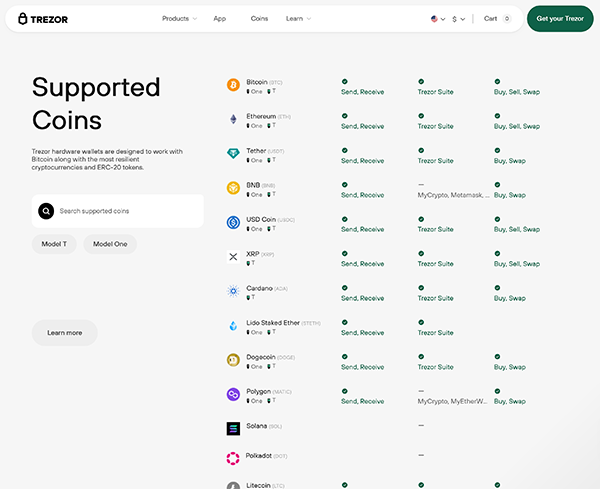
Which is the best value?
So if all your coins are supported by both, then you can pick a hardware wallet that fits your budget.
Both have entry level models that start at 60 or 70 dollars and these are perfectly good devices that will do everything you need it to. And if you want a better experience, such as a color screen, larger display, touch screen, the Trezor offers the Model T for $220 and Ledger offers the Ledger Nano X for $150 and the Ledger Stax for $280.
Going for the higher model should depend on how much you value the premium experience and, of course how much crypto you're entrusting it with. Both companies offer a variety of different experiences at different tiers, so you'll just have to compare each model to see if the added value is worth it to you.
Which device has the best User Interface?
As far as the desktop apps go, both offer a great experience.
Ledger has Ledger Live to view crypto balances and to initiate transactions, and Trezor has Trezor Suite which offers a similar experience. But as far as the user experience on the device itself goes, I've found that Trezor has the best User Interface.
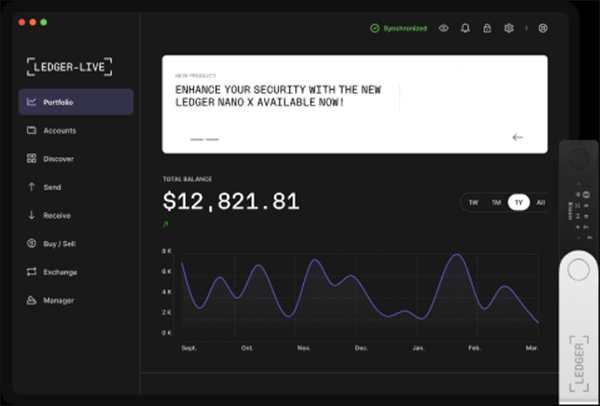
With the Ledger, adding support for each coin requires installing a separate “app” on the device. What was even more frustrating to me was that their first model only had the capacity to store 4 or 5 apps at a time, so managing more coins than that often required uninstalling and reinstalling apps.
Since then, they've addressed this issue with the Model S Plus and newer models, but I still find navigating from app to app a bit cumbersome on the device.
I believe Trezor has the superior UI, especially if you have the touchscreen Model T. But even the Trezor 1 is simple to use and the larger screen has always made it a lot easier to navigate.
Giant Corporate Red Flags
Hacked Marketing Database
But apart from the device itself and the desktop app experience, I have a big problem with Ledger, because back in 2020, I was a victim of the hack that they suffered.
And to be clear, no coins were stolen and the hardware itself wasn't compromised, but their customer list was appropriated by hackers in July 2020.
Hackers were able to get a hold of customer's names, email addresses, phone numbers, and home addresses...and they got mine!

I was targeted by a phishing attempt by hackers who sent me an email with a link that I almost clicked on…but to say I felt violated because Ledger allowed this to happen is a big understatement. And I'm 100% certain these scammers got my email address through Ledger's leaked list because the email address they sent it to was used EXCLUSIVELY to purchase the ledger online.
Since I own and manage my own domain names, I always create a new email address for every online account I create for security purposes. Luckily, I've moved to a new home since the data breach happened, but you can imagine how scary it is to know that criminals not only know your home address, but know that you ordered a device specifically used to hold countless wealth.
Leaking thousands of customers' addresses is like sending out thousands of treasure maps to cybercriminals who are just a lead pipe away from having you give up your PIN or seed phrase.
Ledger Recover
And then just a few weeks ago in May, Ledger announced a feature called “Ledger Recover” that caused a big stir in the crypto world.
The Ledger Recover feature was supposed to allow users to have their seed phrase sent off the device in pieces to a list of trusted people who can help you unify the phrase and regain access to your wallet addresses.

Whether authorized or not, many people were concerned that the wallet was able to leak the seed phrase at all, as this really goes against the whole point of having the wallet be the firewall between your computer and your private keys.
Having the ability to recover your seed phrase means that firewall becomes a gateway able to broadcast that super sensitive data.
Other Missteps
And to add salt to the wound, Ledger was criticized for making other missteps, including creating models with fashionable colors and a sporty lanyard that basically painted a bullseye on the wearer as a Mark for getting robbed.
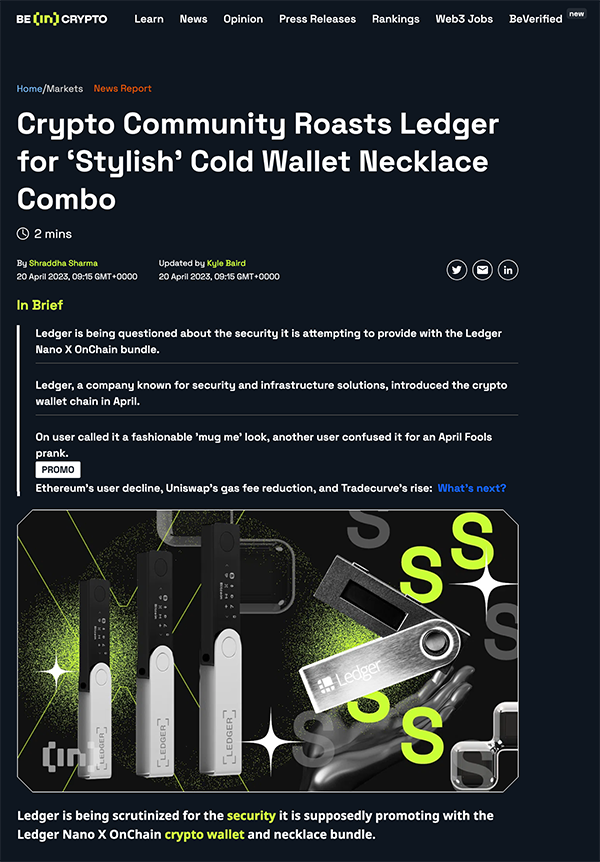
It just appears that Ledger is constantly working on solving problems that no one has. And these changes seem to actively make their product less desirable.
So for these reasons, I'm a huge supporter of Trezor and their line of products. If they support your coins, then they're definitely what I'd recommend you use. And that's why I'm giving away 3 Trezor Model Ones!
They're not paying me to make this blog post, but they are supplying the prizes for this giveaway. You'll be shipped the wallet directly from Satoshi Labs, the company behind Trezor.
Quick Crypto Wallet Tips
When you make the leap into crypto self-custody, there are a couple of tips you can follow to keep your crypto extra secure.
How to Store your Seed Phrase
Pen and Paper
There are a few options for storing your seed phrase. The basic approach to securing your seed phrase is to just use pen and paper. Just write down your 24 word phrase on paper and store it in a secure place like a safe in your home.
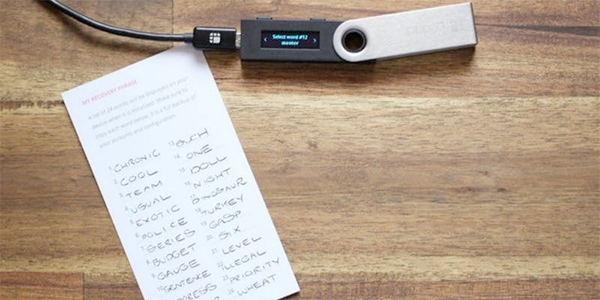
Steel Wallet
Another option is to store the phrase on a steel wallet that is stamped, etched, or assembled with alphabetic tiles. This is more secure than paper, since it's resistant to damage from flood and general wear and tear.
But this option can cost between 50 and 75 dollars. And if you mess up while scribing your seed words, you could ruin the whole steel wallet.
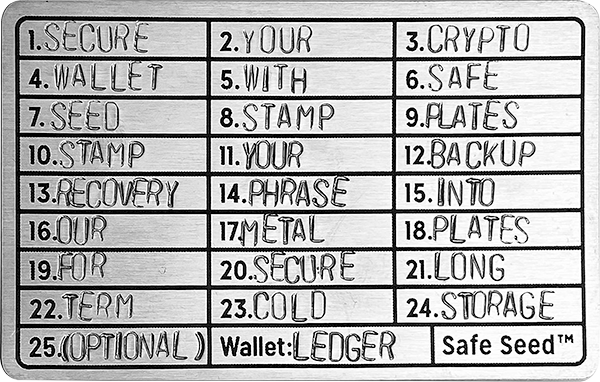
Fender Washer Wallet
So I prefer to use something cheaper and something that's a lot easier to fix when you make a mistake. I've been etching the phrase on fender washers that cost about 6 cents each.
Scribing the entire 24 word phrase on 12 washers (front and back) only costs under a dollar, even if I cap the washers off with blanks.
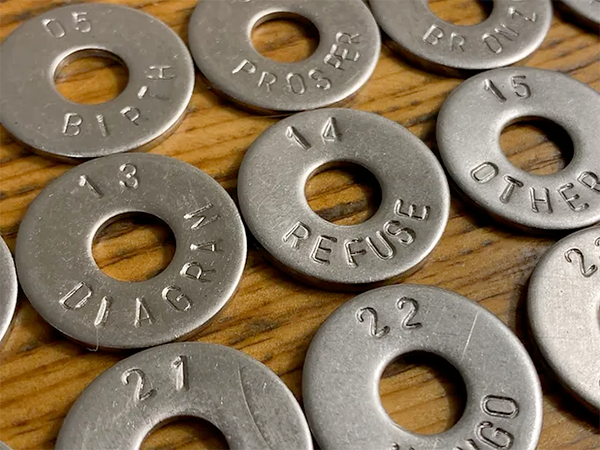
But whatever you do, DON'T store the seed phrase electronically.
- Don't put it in a Google Doc.
- Don't store it in the cloud.
- Don't even save it in a password manager.
It's not safe in ANY of those places.
In fact, whenever I record any of my seed phrases, I make sure I don't accidentally expose the paper to any of the cloud connected security cameras I have around my house. It would be extremely easy for someone to scrub through text files stored in the cloud and check for a list of words that match the 2048 possible seed phrase words specified in the BIP-39 specification.
Use 2 Wallets!
And if you can afford it, it really helps if you have two of the same hardware wallet.
Check your Seed Phrase with a 2nd Wallet
With 2 wallets, you can check to make sure you've recorded your seed phrase correctly without having to reset and restore your main wallet from scratch.
If at any point your seed phrase gets lost, you can initialize the backup wallet and transfer your coins to it with just your PIN.
And another thing I do with my backup wallet is apply firmware updates to it first.
Dry Run Firmware Updates on the 2nd Wallet
I'll apply firmware updates to the second wallet to see if everything still works properly before updating the firmware in my main wallet. Because if you apply a bad firmware update or if you leave the device in a bad state, you might end up bricking it, making it completely useless.
And you'd have to buy a new one, wait a few days while it's delivered, and restore your seed phrase to regain access to your coins.
For those two reasons and for many more, it's just better to have two devices available.
The Dangers of Self-Custody
Of course, there are dangers of self-custody as well.
When you're in charge of maintaining your seed phrase, you're really in charge. There's no way to reset your password if you forget it like with Gmail or your Apple ID.
So if you lose your seed phrase, it's a CERTAINTY that you won't be able to recover your crypto from scratch.
Hardware Wallet GIVEAWAY Details!
So, back to the giveaway - I'm giving away 3 TREZOR ONE HARDWARE WALLETS!
If you want to enter the giveaway, go to my YouTube video and like it, subscribe to the channel, and Comment on the video with what coins you plan to store on the wallet!
You can also email me at [[EMAIL-NO-LONGER-ACTIVE]].
I'll pick 3 random winners amongst the YouTube commenters and email submitters and I'll notify you when you win. You'll be shipped the hardware wallet directly from Satoshi Labs in the Czech Republic, so there's no need to worry about possible tampering.
But of course, you should STILL verify that it's securely sealed before you initialize it.
On August 25, 2023, I'll randomly pick 3 winners and I'll announce the winners on August 26, so LIKE, SUBSCRIBE, AND COMMENT NOW!
